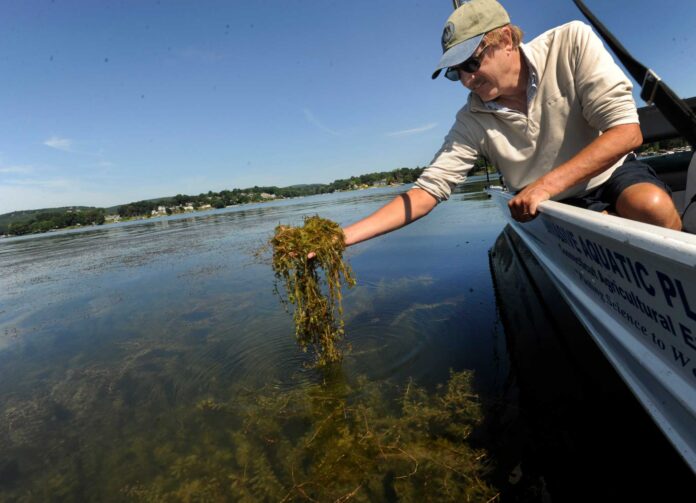Deceptively delicate and fragile in appearance, the Eurasian watermilfoil forms thick mats in shallow areas of a lake, quickly growing and spreading to block sunlight, killing off native aquatic plants that fish and other underwater species rely on for food and shelter.
In North America, the plant threatens the diversity and abundance of native plants as well as the ecological balance of lakes and ponds, which in turn adversely affects recreational opportunities. If left unchecked, invasive watermilfoil will spread through a lake, or even to other lakes by transmission.
Recreationists are often inadvertent culprits in the spread, when even a fragment of the Eurasian watermilfoil attaches to boat hulls or gets caught in propellers, fishing gear or swim rafts.
Eurasian watermilfoils were first documented in the U.S. in the 1940s, likely brought here as a stowaway on the ballast of a ship. More than 80 years later, the plant, native to Europe, Asia, and North Africa, is difficult to remove and causes problems below and above the water’s surface.
The plant can become attached to boat hulls and propellers and end up catching a ride to wherever the boater goes next. If left unattended, invasive watermilfoil will spread throughout the lake – or to another lake.
An expert team of USDA Forest Service divers with invasive species and aquatics expertise is focused on rooting out the plant. The rubber-clad divers pull the plants from the bottom of lakes, then pass them up to the surface. The waiting crew on the dock gathers and securely loads the weeds into pickup trucks to haul away. Another staff member hovers above the divers on a stand-up paddleboard with a dive marker to keep boaters clear of the work area.
All that work stirs up the mud from the bottom of the lake, making it hard for the divers to see anything. Much of their work is through feeling and not seeing the plant.
“We sift through the mud on the bottom with our fingers to pull the milfoil out by the roots,” said Bruce Hansen, an aquatic ecologist with the Pacific Northwest Research Station, who has been a member of the dive team since 2004.
If you are a recreationist who enjoys time on lakes, please be sure to check your watercraft and tools for invasive species before leaving the area. Always clean, drain and dry your watercraft, tools and gear when you return to shore.

